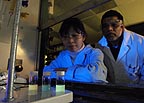March 07, 2011
New technique may detect harmful bacteria

CARBONDALE, Ill. — Like a detective knows a suspect's habits, researchers know a lot about the tendencies of harmful bacteria.
A researcher at Southern Illinois University Carbondale is playing the role of a sleuth in setting up a classic "sting" operation to bust microbes like e. coli and deadly staphylococcus using a classic decoy ploy.
Punit Kohli, assistant professor of chemistry and biochemistry in the College of Science at SIIUC, is using nano-scale technology to engineer what are essentially artificial antibodies that will bind with and indicate the presence of those germs. His research, funded by a two-year, $216,000 grant from the National Institutes of Health, might one day even open the door for such techniques to also attack and neutralize such microbes.
Kohli and his graduate students are making the tiny "sacks" — 50 to 150 nanometers in size — in a laboratory at SIUC. A nanometer is one-billionth of a meter long.
The sacks, made from organic materials such as carbon, hydrogen and phospholipids, have sensors on their surfaces that researchers engineer to bind with specific microbes. Researchers know a microbe's habits the way a cop knows a criminal, and Kohli is using these "profiles" to set up his sting.
When researchers place the receptor-laden sacks in a solution or serum they act as a decoy for the microbe and the two bind. The action simulates the way a normal antibody attaches itself to an invading microbe, and how a microbe attacks a normal cell. The bond works like a "lock and key" mechanism, based on the structure and compounds that make up the receptors.
In this case, however, instead of causing illness the bond causes a fluorescent reaction, which grows greater based on the number of bonds that occur in the solution. Researchers can detect this reaction, either with a light-measuring instrument or sometimes even the naked eye, with the glow indicating the presence of specific microbes.
And the case is solved.
The test should be very fast and accurate, Kohli said. It also will detect extremely low concentrations of the microbes.
Kohli envisions using the technique on a series of test strips or slides, each containing sacks and receptors specifically engineered to detect different microbes or proteins. Researchers could use it, for instance, to monitor food and water supplies or to detect the presence of diseases such as cancer.
Eventually, researchers might figure out ways to make the sacks deliver drugs to the invading microbes after binding with them. Delivering drugs in such a highly targeted way would theoretically cut down on medication side effects, Kohli said.
"This is one of the side projects we're working on," he said.
Kohli and his graduate assistant, Xuelian Li, already have shown the technique will work for detecting the presence of certain proteins and plan to submit a paper on their work within a few months. That success bodes well for the overall concept, Kohli said.
"If we can detect proteins it should be possible to detect larger particles," he said.
Li is busy making the nano-sized sacks in a laboratory. The sacks form themselves in a beaker solution during sonication, or agitation via sound waves. The researchers can engineer the sacks based on the compounds they use to create them and other variables. After they form, the researchers polymerize the sacks.
"This makes them very strong and robust, which is what we want," Kohli said.
Caption:
Creating on a nano scale – Punit Kohli, right, assistant professor of chemistry and biochemistry in the College of Science at Southern Illinois University, observes a fluorescent reaction that indicates the presence of certain microbes as his graduate assistant, Xuelian Li, looks on. Kohli received a $216,000 grant from the National Institutes of Health to develop ways to quickly and accurately detect very small amounts of e. coli and staphylococcus microbes using nano-scale sacks with receptors that bind such bacteria. When the two bind they give off a fluorescent reaction, which grows brighter depending on the amount of material present. Li helps make the nano sacks used in the experiments.
Photo by Russell Bailey
